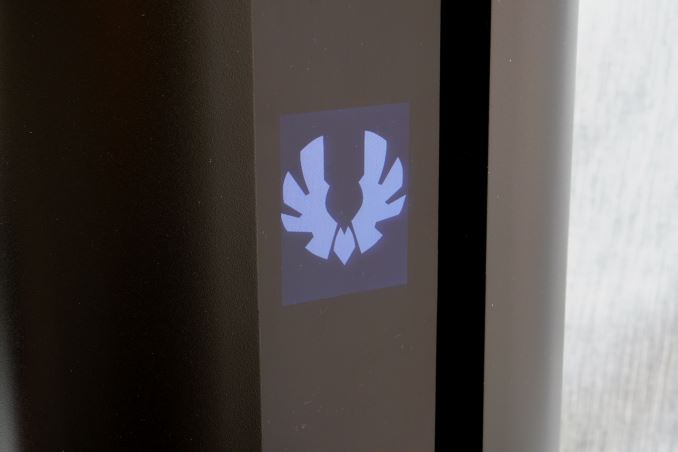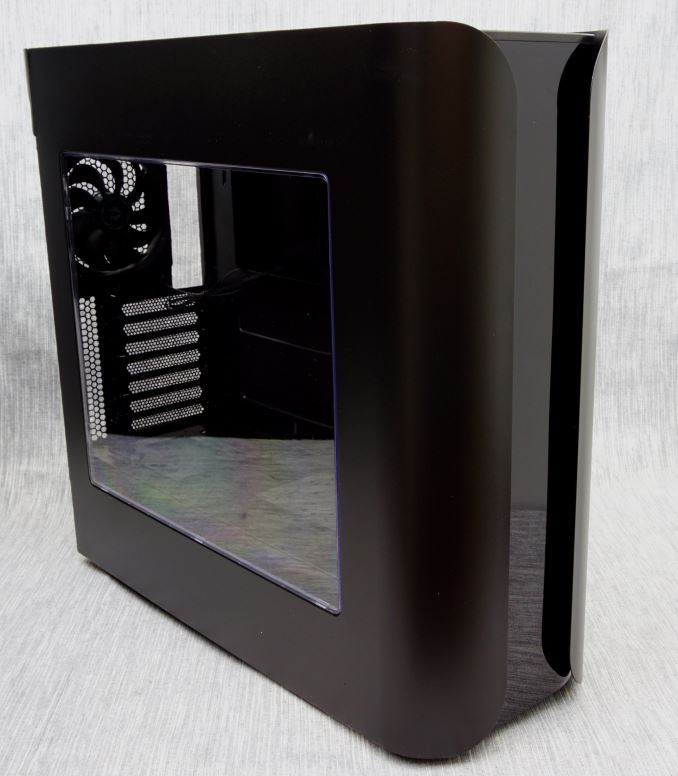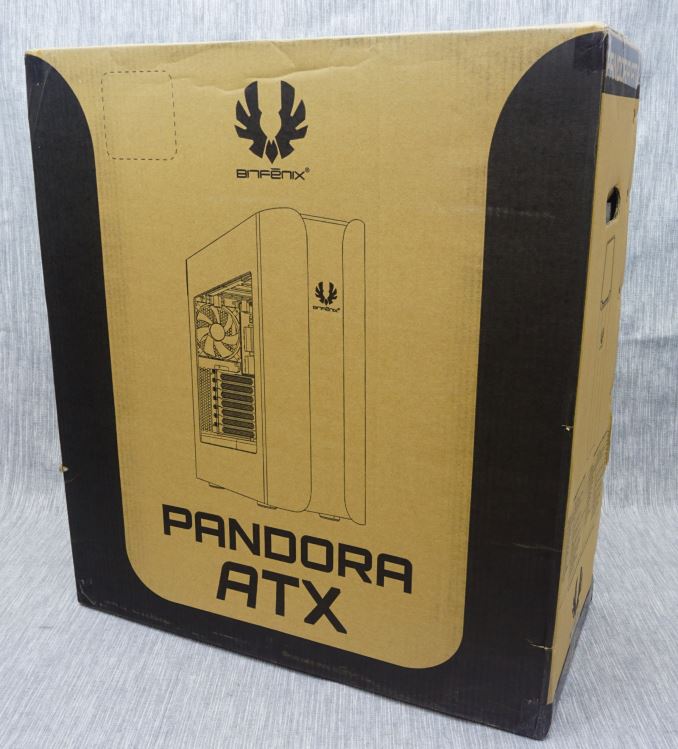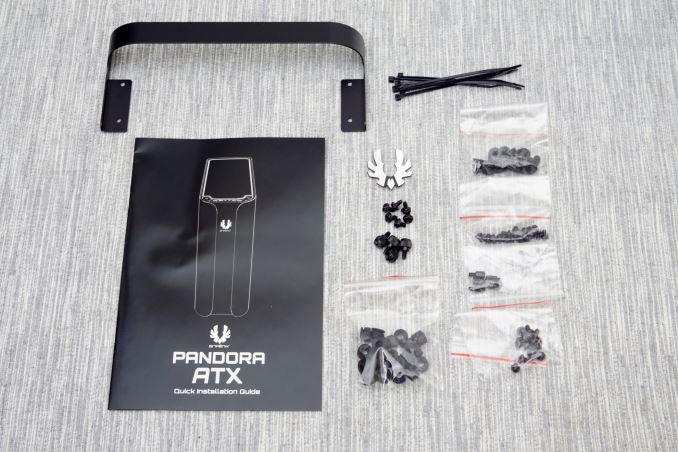The BitFenix Pandora ATX Case Review
by E. Fylladitakis on August 11, 2016 9:00 AM EST- Posted in
- Cases/Cooling/PSUs
- bitfenix
- ATX
- Case

BitFenix is a company that is strongly focused on the design of PC cases and the supply of case modding parts. They currently produce over two dozen cases, covering nearly all segments of the market, with most of them being marketed as visually unique cost-effective designs. Many of their products have been through our labs, from the $39 Merc Alpha to the $159 Shinobi XL, each with its own target group, strengths, and weaknesses. Today we are looking at the latest design - a scaled up version of the Pandora.
BitFenix owes a lot of their recent success as a company to the Pandora. It is a case that was loved for its design and price to performance ratio. However, the Pandora was compact and could only take up to Micro ATX motherboards, with limited expandability and cooling options. In this review we are having a look at a newer version of the Pandora, the Pandora ATX, which shares the aesthetic design of the original Pandora but is both much larger and comes with extensive support for liquid cooling systems.
Introduction
Tthe Pandora was BitFenix’s first case with aluminum parts and designed to combine aesthetics with versatility. The original Pandora was designed for Micro-ATX and Mini-ITX motherboards only, something that was a deal breaker for many advanced users and gamers, but did not stop the case from succeeding in the market. As such, BitFenix decided to design an oversized version of the Pandora, the Pandora ATX, as a case with a similar aesthetic design but large enough to support ATX motherboards and advanced liquid cooling systems. We are having a thorough look at it in this review.
| BitFenix Pandora ATX | ||
| Motherboard Size | ATX, Micro-ATX, Mini-ITX | |
| Drive Bays | External | - |
| Internal | 4 × 3.5" 4 × 2.5" |
|
| Cooling | Front | 3 × 120 mm or 2 x 140 mm (1 × 140 mm included) |
| Rear | 1 × 120 mm (included) | |
| Top | 3 × 120 mm or 2 x 140 mm (none included) | |
| HDD | - | |
| Bottom | - | |
| Radiator Support | Front | Up to 360 mm or 280 mm |
| Rear | Up to 120 mm | |
| Top | Up to 360 mm or 280 mm | |
| Side | - | |
| Bottom | - | |
| I/O Port | 2× USB 3.0, 2× USB 2.0, 1× Headphone, 1× Mic | |
| Power Supply Size | ATX | |
| Clearances | HSF | 160 mm |
| PSU | 240 mm | |
| GPU | 440 mm | |
| Dimensions | 510 mm × 203 mm × 558 mm 20.08 in × 7.99 in × 21.97 in |
|
| Prominent Features | · 2.8" BitFenix ICON™ Display · One-piece powercover and MB tray · Top, Front and Bottom Dust Filters · 360mm Radiator Support · 20mm Cable Clearance · Graphics Card Length up to 440mm |
|
| Price | $112 | |
Packaging & Bundle
We received the Pandora ATX supplied inside a large and fairly sturdy cardboard box. The case is protected inside the box by two thick Styrofoam slabs and a nylon bag, providing adequate shipping protection. Aesthetically it may be just a brown box, but BitFenix spent some effort and resources trying to make it appealing via simple geometric artwork and a schematic of the case itself.
The items bundled alongside with the Pandora ATX are fairly standard, with the exception of a metallic brace that can be installed to give the rear of the chassis a rounded appearance. The rest of the supplied items are for the installation of devices and parts inside the case, a few cable ties, and a thick metallic company logo. As this case has an LCD installed, BitFenix thoughtfully decided to leave the installation of the case badge up to the user.













26 Comments
View All Comments
fanofanand - Thursday, August 11, 2016 - link
I understand that everything is designed to a price point, but how much more expensive could it have possibly been to go with all USB 3.0 instead of the 2 USB 2.0 ports? With backwards compatibility this makes no sense to me. USB 3.0 debuted at the end of 2009, we are talking almost 7 years here, I simply cannot understand this decision.woggs - Thursday, August 11, 2016 - link
All motherboards still have USB2.0 sockets and very few have more than one USB3.0 for the front panel. I was happy to see they put both because both is useful for the vast majority of folks. And, I wonder if they would sell you a USB3 replacement for those if you happen to have 2 USB3 sockets on your MB.fanofanand - Thursday, August 11, 2016 - link
I understand that all motherboards have 2.0 sockets but that is again, borne out of cost. With backwards compatibility there is literally zero reason for this. I understand why some legacy ports remain, like PS/2 (many cannot access the bios with a USB keyboard) but with USB it makes no sense. You say "I was happy to see they put both because both is (sic) useful" but there is literally no benefit to USB 2.0 over USB 3.0. I am unaware of a single device that works on USB 2.0 but not 3.0.DanNeely - Thursday, August 11, 2016 - link
I'd be happy if case makers would just offer double header cables with a USB3 and USB2 header on the end. If you've only got one 3.0 header on your mobo it's not that hard to remember which pair of ports are faster; and it gives full support if you've got two 3.x headers. For a forward looking setup today at least one C port would be nice; maybe 2 because actually filling up all 4 front ports isn't that common and it'd give better future proofing.Wider support from the mobo vendors is needed too. I was able to get 2x headers for my Haswell build; but that requirement severely limited my available mobo vendors (I ended up with an MSI board). (I also went with a Case Labs case that used a painted to match 3.5" bay device for its front panel support so that I can easily switch to a setup with C ports in the future; but realize that their cases are far to expensive for the average enthusiast.)
slyronit - Friday, September 2, 2016 - link
On my desktop PC, WIndows device recovery tool cannot flash my Lumia 950XL if it is connected to a USB 3.0 port (either on the front panel or the rear motherboard port). This has happened across Windows 8, 8.1 and now Windows 10, chipset/USB drivers always updated (Tried both the drivers from Windows Update and the Asus drivers). But for such cases, I can make do with a rear USB port.slyronit - Friday, September 2, 2016 - link
And this is all the more surprising, because the phone itself supports USB 3.0 and when connected to my SP3 dock USB 3.0 port, there's a noticeable speed improvement, compared to USB 2.0.RaichuPls - Thursday, August 11, 2016 - link
Some wireless mice/headsets don't play well with USB3.0, such as the Logitech G930 and G602. In my case, interference from USB3.0 ports severely reduce the wireless range of both.eek2121 - Thursday, August 11, 2016 - link
I have 2 devices that don't work with USB 3.0. A headset as well as a high end microphone. The need for USB 2.0 still exists. Manufacturers are aware of this and that's why they haven't dropped USB 2.0. Believe me, if manufacturers could drop USB 2 they would. Going all USB 3.0 would actually LOWER costs.fanofanand - Thursday, August 11, 2016 - link
Thank you eek and Raichu, I was unaware of those issues. I do stand corrected. :) How's this, I wish motherboard makers would at least provide an option with no legacy ports. For those completing a new build, the less legacy the better.kaidenshi - Sunday, August 14, 2016 - link
USB 3.0 isn't 100% backwards compatible across all devices, though. There are some USB 2.0 devices out there that don't enumerate properly or tend to lose communication when plugged into a USB 3.0 socket. Usually the product's support site will have a KB entry about this, and they will suggest using a 2.0 port. I've personally had this issue with a couple of different USB flash drives and with an Android cellphone.In short, USB 2.0 on a case in 2016 is a positive, not a negative thing.